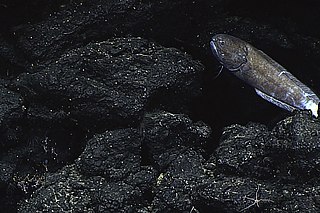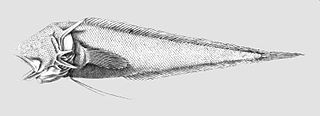
Norfolkia is a genus of triplefins in the family Tripterygiidae. They are found I the Indo-Pacific region.

Centropyge heraldi, the yellow angelfish or Herald's angelfish is a species of marine ray-finned fish, a marine angelfish belonging to the family Pomacanthidae. It comes from the Pacific Ocean that sometimes makes its way into the aquarium trade.
Schultzites is a genus of freshwater fish in the family Characidae. It contains the single species Schultzites axelrodi, which is endemic to Colombia, where it is found in the upper Meta River basin.
Onuxodon is an Indo-Pacific genus of pearlfishes from the family Carapidae. The generic name is derived from the Greek onyx meaning "claw" and odon meaning "tooth", referring to the sharp fang like teeth of Onuxodon parvibrachium. Species in this genus are distributed from South Africa to Hawaii. They live commensally with molluscs. The three currently recognized species are:
Alcockia is a genus in the cusk-eel family. It contains only the single species Alcockia rostrata, which is found in the Indian and western Pacific Oceans, at depths of from 2,761 to 4,040 metres. This species grows to a length of 35 centimetres (14 in) SL. The generic name Alcockia honours Alfred William Alcock (1859-1933) who was the surgeon-naturalist aboard the R.I.M.S. Investigator.
Bassogigas is a genus of cusk eel from the subfamily Neobythitinae, part of the family Ophidiidae. The generic name "Bassogigas" comes from a combination of two Latin words: bassus, which means "deep" and gigas which means "giant". The species are found in the Indo-Pacific and western Atlantic Ocean.
The Australian tusk, Dannevigia tusca, is a species of cusk-eel found in the waters off of the Great Australian Bight occasionally to Bass Strait at depths from 115 to 400 m. This species grows to 56 cm (22 in) in total length. It is the only known member of its genus and the generic name honours Harold Christian Dannevig (1860-1914) who was the Director of Fisheries for the Australian government, who collected type specimen and who was later lost at sea when the fisheries research vessel he was working on vanished without a trace.

The needletooth cusk is a species of cusk-eel found in the Indian and the western Pacific Ocean where it occurs at depths of 1,000 to 1,750 metres. This species grows to a length of 21.5 centimetres (8.5 in) SL. It is the only known species of its genus The generic name is a compound of the Greek epetrion meaning "needle" and odous meaning "tooth", while the specific name honours the English ichthyologist Norman Bertram “Freddy” Marshall (1915-1996) who worked on deep sea fishes as the British Museum.
The banded cusk-eel is a species of cusk-eel found along the southeast coast of South America from southern Brazil to northern Argentina. It occurs at depths of from 40 to 150 metres and is of minor importance in commercial fisheries. This species grows to a length of 31 centimetres (12 in) TL. It is the only known member of its genus. The generic name honours the American ichthyologist Edward C. Raney (1909-1984) of Cornell University who introduced the describer Charles R. Robins to ichthyology.

Tauredophidium hextii is a species of cusk-eel found in the Indian and western Pacific Oceans. It occurs at depths of from 1,500 to 2,660 metres. This species grows to a length of 10.5 centimetres (4.1 in) SL. It is the only known member of its genus. The specific name honours Rear-Admiral John Hext (1842-1924) who was commander of the Royal Indian Marine who supported the expedition in board the R.I.M.S. Investigator in the Arabian Sea which collected the type specimen.
The East Pacific ventbrotula is a species of cusk-eel found around thermal vents on the southern East Pacific Rise at depths of about 2,586 metres (8,484 ft). This species grows to a length of 28.2 centimetres (11.1 in) SL. It is the only known member of its genus. The generic name is a compound of vent, for the Oasis hydrothermal vent on the south East Pacific Rise and the Greek ichthys meaning "fish", while the specific name refers to the French BIOSPEEDO expedition to the south East Pacific Rise which collected the type specimen in 2004.

Roche's snake blenny is a fish species in the genus Ophidion and the family Ophidiidae. Widespread in the Mediterranean Sea in western and northern regions, also in the Black Sea, Sea of Marmara and it has been recorded in the Atlantic. Marine subtropical demersal fish, up to 29.3 centimetres (11.5 in) long. The specific name honours the Swiss physician and naturalist François-Etienne Delaroche (1780-1813), who wrote about the distinctive swim-bladder anatomy of Ophidion barbatum in 1809.

Cirrhitops is a genus of marine ray-finned fish, hawkfishes from the family Cirrhitidae. They are found on tropical reefs of the Indian Ocean and the Pacific Ocean.
The Johnston snake eel, also known as the peppered worm eel in Micronesia and Hawaii is an eel in the family Ophichthidae. It was described by Leonard Peter Schultz and Loren Paul Woods in 1949. It is a marine, tropical eel, which is known from the Indo-Pacific region, including the Chagos Islands, Hawaii, the Marquesan Islands, the Society Islands, Australia, and New Caledonia. It dwells at a depth range of 2–23 m, and inhabits sand sediments in coral reefs. It can reach a maximum total length of 35 cm.
Bascanichthys myersi is an eel in the family Ophichthidae. It was described by Albert William Herre in 1932. It is a tropical, marine eel which is known from the western central Pacific Ocean, including Dumaguete, Negros Oriental, in the Philippines.
Lamnostoma taylori is an eel in the family Ophichthidae. It was described by Albert William Herre in 1923, originally under the genus Caecula. It is a tropical, freshwater eel which is known from the Philippines in Asia, where it inhabits rivers near the sea. Males can reach a maximum standard length of 16.4 centimetres (6.5 in).
Pisodonophis copelandi is an eel in the family Ophichthidae. It was described by Albert William Herre in 1953. It is a marine, tropical eel which is known from the Philippines, in the western central Pacific Ocean. Males can reach a maximum standard length of 30.8 centimetres (12.1 in).
The panatela silverside is a species of reef-dwelling silverside from the subfamily Atherinomorinae which is found in the southwest Pacific Ocean. This species grows to 11 cm (4.3 in) in total length and is of minor importance to commercial fisheries. This species is the only species in the genus Stenatherina, although some authorities place it in the genus Hypoatherina. This species was described by David Starr Jordan and Robert Earl Richardson as Atherina panatela with the type locality given as Calayan Island in the Philippines. The specific name is the Spanish word for a long, thin cigar and is presumed to be a reference to the elongated, slender body of this fish.
Natalichthys is a genus of ray-finned fishes, classified under the subfamily Congrogadinae, the eel blennies, part of the dottyback family, Pseudochromidae. They are found in the western Indian Ocean off the eastern coast of South Africa, the genus being named after Natal, where all three species in the genus are so far restricted to.
Rusichthys is a genus of ray-finned fishes, classified under the subfamily Congrogadinae, the eel blennies, part of the dottyback family, Pseudochromidae, from the western Indian Ocean. The generic name is a compound of the acronym RUSI which stands for Rhodes University Smith Institute and thus honours the South African ichthyologist James Leonard Brierley Smith





